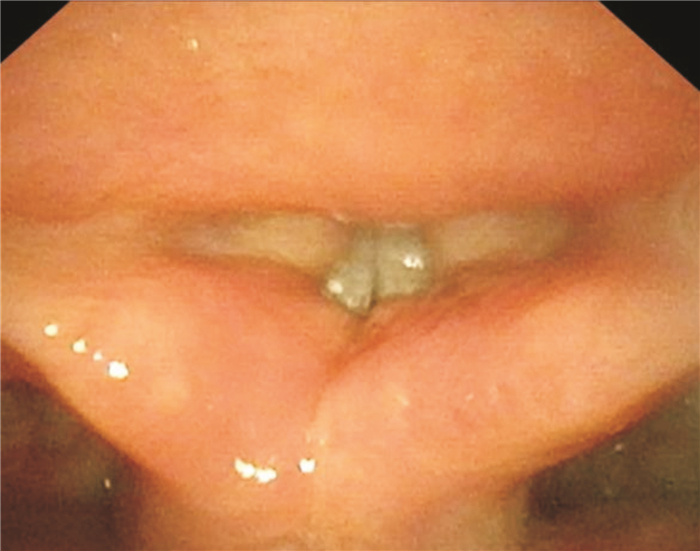Preliminary analysis of the effect of individualized voice therapy on pediatric voice disorders
-
摘要: 目的 明确个性化嗓音训练治疗持续性儿童嗓音障碍的有效性。方法 纳入2021年11月—2022年10月因“持续性嗓音障碍”就诊于南方医科大学深圳医院儿童耳鼻喉科患儿38例。对所有患儿进行嗓音训练前的动态喉镜评估;于训练前后分别由2名嗓音医师对患儿声音样本进行主观GRBAS评分及客观声学分析,获得基频(F0)、频率微扰(Jitter)、振幅微扰(Shimmer)、最长发声时长(MPT)相关参数;对所有患儿进行为期8周的个性化嗓音训练。结果 38例嗓音障碍患儿中声带小结29例(75.8%),声带息肉8例(20.6%),声带囊肿1例(3.4%)。所有患儿中合并继发性高功能发声障碍即动态喉镜下显示有声门上挤压征象者占51.7%(20例);所有患儿GRBAS评分由1.93±0.62、1.82±0.55、0.98±0.54、0.65±0.48、1.05±0.52下降到0.62±0.60、0.58±0.53、0.32±0.40、0.22±0.36、0.37±0.36;所有患儿F0、Jitter、Shimmer分别由(243.11±39.73) Hz、(0.85±0.99)%、(9.96±3.78)%降至(225.43±43.20) Hz、(0.33±0.57)%、(7.72±4.32)%,MPT由治疗前(5.82±2.30) s延长至(7.87±3.21) s。治疗前后所有参数变化差异均有统计学意义。结论 嗓音训练能解决儿童嗓音问题、改善声音质量并有效治疗儿童嗓音障碍。Abstract: Objective To determine the effectiveness of individualized voice therapy in persistent pediatric voice disorders.Methods Thirty-eight children who were admitted to the Department of Pediatric Otolaryngology Shenzhen Hospital, Southern Medical University due to persistent voice disorder from November 2021 to October 2022 were included. All children were evaluated by dynamic laryngoscopy before voice therapy. Two voice doctors performed GRBAS score and acoustic analysis on the children's voice samples to obtain the relevant parameters including F0, Jitter, Shimmer, and MPT; All children were given personalized voice therapy for 8 weeks.Results Among 38 children with voice disorders, 75.8%(29 cases) were diagnosed with vocal nodules, 20.6%(8 cases) were vocal polyps, and 3.4%(1 case) were vocal cysts. And in all children. And 51.7%(20 cases) had the sign of supraglottic extrusion under dynamic laryngoscopy. GRBAS scores decreased from 1.93 ± 0.62, 1.82 ± 0.55, 0.98 ± 0.54, 0.65 ± 0.48, 1.05 ± 0.52 to 0.62 ± 0.60, 0.58 ± 0.53, 0.32 ± 0.40, 0.22 ± 0.36, 0.37 ± 0.36. F0, Jitter, Shimmer decreased from(243.11±39.73) Hz, (0.85±0.99)%, (9.96±3.78)% to(225.43±43.20) Hz, (0.33±0.57)%, (7.72±4.32)%, respectively MPT was prolonged from(5.82±2.30) s to(7.87±3.21) s after treatment. All parameters changes had statistical significance.Conclusion Voice therapy can solve children's voice problems, improve their voice quality and effectively treat children's voice disorders.
-
Key words:
- voice therapy /
- pediatric voice disorders /
- voice assessment /
- Individualized treatment
-

-
表 1 嗓音训练前后GRBAS评分比较(n=38)
GRBAS评分 治疗前 治疗后 t P 总嘶哑度 1.93±0.62 0.62±0.60 10.91 0 粗糙度 1.82±0.55 0.58±0.53 10.51 0 气息度 0.98±0.54 0.32±0.40 7.58 0 无力度 0.65±0.48 0.22±0.36 5.57 0 紧张度 1.05±0.52 0.37±0.36 8.07 0 表 2 嗓音训练前后计算机声学参数分析比较(n=38)
参数 治疗前 治疗后 t P F0/Hz 243.11±39.73 225.43±43.20 2.91 0.006 Jitter/% 0.85±0.99 0.33±0.57 2.78 0.008 Shimmer/% 9.96±3.78 7.72±4.32 3.42 0.002 MPT/s 5.82±2.30 7.87±3.21 -5.28 < 0.001 -
[1] Devadas U, Dhanya M, Gunjawate D. Adaptation and validation of the Malayalam pediatric voice handicap index[J]. Int J Pediatr Otorhinolaryngol, 2015, 79(9): 1425-1428. doi: 10.1016/j.ijporl.2015.06.018
[2] 吕丹, 黄孟捷, 陈媛, 等. 儿童嗓音障碍指数量表在嗓音疾病患儿中的应用[J]. 中华耳鼻咽喉头颈外科杂志, 2019, 54(2): 121-125.
[3] Hseu A, Ongkasuwan J. Beyond Nodules-Diagnostic and Treatment Options in Pediatric Voice Disorders[J]. Otolaryngol Clin North Am, 2019, 52(5): 949-956. doi: 10.1016/j.otc.2019.06.006
[4] 魏梅, 杜建群, 耿磊, 等. 基于发声与言语障碍分析参数对病理嗓音的检测[J]. 临床耳鼻咽喉头颈外科杂志, 2022, 36(7): 492-496. https://lceh.whuhzzs.com/article/doi/10.13201/j.issn.2096-7993.2022.07.002
[5] Ma EP, Cheung YC, Siu AK, et al. The Effectiveness of Vocal Hygiene Education With Resonant Voice Therapy for School-Aged Children With Vocal Nodules[J]. J Voice, 2021.
[6] Sales NJ, Queiroz Gurgel R, Rebelo Gonçalves MI, et al. Vocal function and vocal discomfort in sheltered and non-sheltered 7-to 10-year-old school children in Aracaju, Brazil[J]. J Voice, 2013, 27(5): 656.
[7] 王世康. 儿童嗓音训练[M]. 重庆: 西南师范大学出版社, 2008: 2-2.
[8] Mohammadzadeh A, Sandoughdar N. Prevalence of Voice Disorders in Iranian Primary School Students[J]. J Voice, 2017, 31(2): 263.
[9] Liu J, Cao W, Sun DH, et al. Vocal nodules in children: Laryngoscopic morphological classification aids prognostic judgment[J]. Front Pediatr, 2022, 10: 941483. doi: 10.3389/fped.2022.941483
[10] Rosen CA, Gartner-Schmidt J, Hathaway B, et al. A nomenclature paradigm for benign midmembranous vocal fold lesions[J]. Laryngoscope, 2012, 122(6): 1335-1341. doi: 10.1002/lary.22421
[11] Szklanny K, Gubrynowicz R, Ratyńska J, et al. Electroglottographic and acoustic analysis of voice in children with vocal nodules[J]. Int J Pediatr Otorhinolaryngol, 2019, 122: 82-88.
[12] Feinstein H, Abbott KV. Behavioral Treatment for Benign Vocal Fold Lesions in Children: A Systematic Review[J]. Am J Speech Lang Pathol, 2021, 30(2): 772-788.
[13] Tezcaner CZ, Karatayli Ozgursoy S, et al. Changes after voice therapy in objective and subjective voice measurements of pediatric patients with vocal nodules[J]. Eur Arch Otorhinolaryngol, 2009, 266(12): 1923-1927.
[14] Rodney JP, Sataloff RT. The Effects of Hormonal Contraception on the Voice: History of Its Evolution in the Literature[J]. J Voice, 2016, 30(6): 726-730.
-





 下载:
下载: